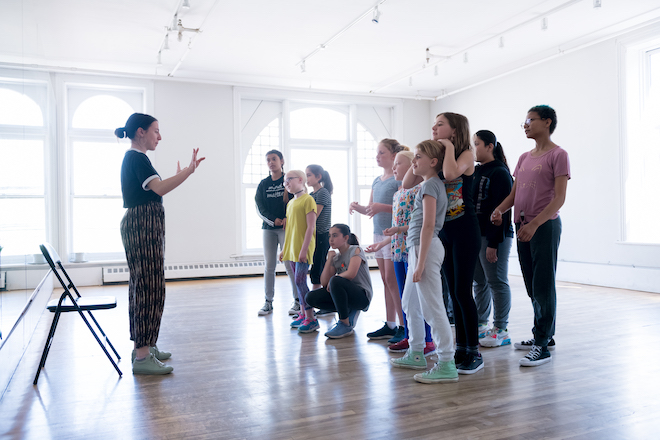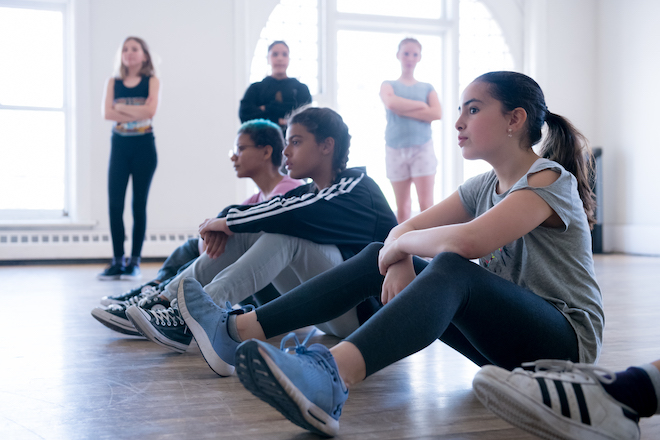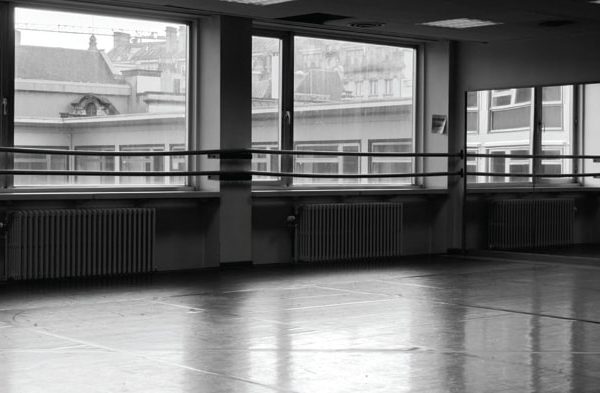Dance competitions in Canada are becoming more and more popular, but they’ve got teachers at odds. There seems to be three choices for studio owners – go all in, dabble in or forgo them altogether. But what values are associated with the competitive world?
I sat down with Jennalee Desjardins, youth director at City Dance Corps in Toronto, and Sean Boutilier, artistic director and founder of Sean Boutilier Academy of Dance in Mississauga and Etobicoke. Desjardins’ program at City Dance Corps focuses on performance-based, non-competitive training that she describes as “a manifestation of goals and ideas.” The studio has just started their first youth performance company. The students train in ballet, jazz, acro, contemporary and Desjardins’ specialty, hip hop. Although non-competitive, the program is for dancers who want performance experience and a taste of what it’s like to live a dancer lifestyle. The thirteen students perform in festivals and parades across the city. Boutilier’s school has two locations, with almost 1900 students in total. His competitive team has been competing “at a high level” in several styles for over twenty years. The school also produces non-competitive performances.
Sean Boutilier I have really, very strong opinions about this, having been trained to be a dancer. I never competed; I trained. I adjudicated, but I never competed. So, to me it was like landing on a different planet because we performed once a year at the year-end show at the National Ballet School, or when I was young doing recitals at seven years old, but never competed.
Grace Wells-Smith (to Desjardins) Did you ever compete?
Jennalee Desjardins I did, but it was [with] very small schools, and at the time [the prizes were] first, second, third, and that’s it.
SB No top ten soloists.
JD Yeah, and no gold, platinum …
SB Uber, uber, uber gold …
JD Or emerald. So, you placed, and if we didn’t place, there were lots of interesting conversations with the instructor about why, and often it came down to their art, and they were like, ‘Well, we feel like maybe this piece we made wasn’t trendy enough, but we really love it and we think you guys did great,’ or ‘We could do better.’
SB There was much more feedback, I think, years ago. The adjudicators and directors were actually onstage giving more of an adjudication. Also, my big complaint is spending. I just wrote a cheque for, between the two studios, over a hundred thousand dollars to a dance competition.
GWS For entry fees?
SB For entry fees. The clients can pay X number of dollars, and at the studio we’d maybe get twenty to twenty-five per cent of it. You’ve got costumes, you’ve got entry fees, you’ve got traffic costs, you’ve got hotels, you’ve got all this stuff. And then they (the parents) look at us like we’re the bad guys, but actually we’re a bit of a conduit. These dance competitions are making huge amounts of money. That’s why it works. And the other thing is that the number one [dancer] might get $50 or a scholarship that was donated to the dance competition. So, the competitions are giving out very little, when a soloist maybe paid $100 for their entry fee. The top soloist used to get, like, $500. There’s a lot of these competitions that are making a ton of money, and what do you get? A ribbon. They used to give out real trophies and stuff like this. And now, the majority of the competitions are really becoming cheap.
GWS Jennalee, why do you think your studio decided not to compete?
JD I wasn’t there for the genesis of the beginning of the studio. [It’s] sixteen years old now, and I believe the youth program is twelve years old, but they believe (and this is why I work there, because I believe it too) in performance, and we believe in the inherent value of the art and that’s really it. You know, we believe in the dance instructor producing the art, the kids being involved, and we just want it to be process-oriented, and that is the incentive. That is the goal. The goal is to make the dance, love the dance, perform the dance. And that is enough because I mean, yes, money is nice later, but this dance career thing is more like a lifestyle, and you just have to love it.
SB And I agree with this. We’re now going into our thirty-sixth year at the studio. And you have to add sixteen years with The National Ballet of Canada, so I started this way back when, you know, the wheel was being created. But for the first fifteen years of the studio, we didn’t compete. [It was] exactly the same philosophy. And we still have that philosophy today (and most studios do) where we will not ever sacrifice [the students’] technique classes. They may have one particular choreography class where they’ll do work on a piece, but the majority of the classes are all technique-based. And that’s why we’ve had such success. So, I’m totally in support of exactly what you’re saying. It’s a balance sometimes because we’re trying to instill in the mind and the psyche of today’s young child – foundation, foundation, foundation. Not just instant gratification at a dance competition. It’s about the art, and we talk a lot about how we really want to create art; we want to create beauty onstage…. A lot of studios are sacrificing their foundation. And so, parents are paying for an expensive costume and an expensive routine and then when they go to an audition, [the students] actually can’t dance. I’m not trying to throw the whole industry under the bus; I’m just saying I think [the decision to compete] has to be based on the shoulders of the director and the people who make the artistic decisions for that organization. It’s sometimes very subjective.
JD Yes.
GWS Why did you start to compete after fourteen years?
SB I was down in the States guesting with a ballet company, and they heard that this Canadian ballet star was in town, and I was asked to adjudicate for the quarter-finals of an Ed McMahon’s Star Search. And I saw this young boy of nine or ten years old doing a tap routine, and I was blown away. I mean, this was, like, amazing. Then I came back, and there used to be a ten-day dance competition called Brantford Dance Competition directed by Joanne Edie, and she said, ‘Would you come in and for three days, and would you be our ballet judge?’ So, I adjudicated, and I saw this little eleven- or twelve-year-old girl doing The Dying Swan, and she was stunning. So, then I started to think [of competition as] really motivating and really pushing these students, those very special ones that have the potential for a career in dance that wouldn’t maybe have the opportunity to go to a national ballet, to go to a School of American Ballet. And I thought, I need to bring this in and give an opportunity to our children…. I support what this young lady (Desjardins) is doing here, because her performance group and everything else is exactly why we do this. Because maybe one of my kids will come downtown and go to your program, right? So, I’m all for that.
JD So, then what, may I ask, is the point of competing? You and I have an alignment in values. Why still have that competitive side? What does it fulfill? I’m just so curious.
SB For me it’s actually a pain. But the choreographers, the teachers and I, we look at it as an opportunity for that dancer to perform three or four times a year, to get up on that stage. So, we’re still teaching them to be able to take and learn from really good teachers and choreographers and do things very quickly and perform it, which you need to do in our industry. So, I see a lot of really positive aspects to it.
JD I don’t think it’s cut and dried. I taught competitive [dance] for eight years, and I would’ve stayed if it hadn’t had so much other baggage. Especially in hip hop. You know, at the beginning the hip hop category just wasn’t hip hop at all, and I found it revolting. How do I put my students in these hip hop categories against [other groups doing], essentially, cheerleading?
SB I agree. I don’t like when I see an amazing routine – real authentic hip hop – and it doesn’t get the appreciation, or good ballet. Everyone’s a contemporary judge.
JD I would think that, traditionally, competition started from institutionalized styles. I even did Highland. You had people who are RAD-trained, fifty years’ experience, and that was the judge. And then we’re trying to insert these other styles as they come up, hip hop especially. And we’re still sort of, like, finding room. I think it’s possible to create room in competitions for these styles.
SB The stage is also for a dancer, for an artist; it’s like a painter’s canvas and our steps are like the palette of colors. [We could] create the Mona Lisa or a contemporary work by Picasso. So, as choreographers and teachers, this is what competition allows us to do. We actually get to hone our skills. And it was actually Joanne Chapman that said something that I will quote her on: ‘Competition is r and d.’ It’s research and development for dance these days. [So that’s the good thing about dance competitions. But everything that you say, I agree. I love what you said about baggage.

JD Growing up, I assumed someone who started a competition would be an authority figure of some sort. But I really don’t think that’s true anymore. It really is a business. It’s up to the studio director to vet what you bring your dancers to. I’m sure that’s even true of me without competitions. What am I bringing to my vulnerable, impressionable youth and saying is, ‘This is important and valuable,’ and making sure I’ve done my research…. I think in competition, or outside, it’s important to expose [young dancers] to immediate feedback. I’m interested, as a younger director of this program, in finding ways of not just sheltering them from feedback but incorporating it.
SB We both have the same, I think, opinion and approach to competition. I just happen to be a part of it. I just work very hard with my team trying to maintain the positivity of it. It doesn’t always work, but every day is a challenge.
GWS What do you hope your kids get out of your performance program?
JD That’s interesting. I hope to expose them to a more pre-professional level of training and thinking. Kids right now, they’re in one to four or five classes a week, and then they just leave. And we’re just hoping to bring a more holistic view of what it’s like to be a dancer, a dance artist and even potentially a choreographer. I love seeing how they create and not just regurgitate vocabulary.
GWS Do you give them opportunities to make their own choreography?
JD Definitely, definitely. It’s easier in urban dance because freestyle is so essential. And, through freestyling, I get to see a lot of little creations by my students, but I’m trying to bring that to the whole program.
GWS What values do you want your students to be able to take with them, regardless of whether they compete or perform?
JD That’s a good question. I’ll answer for myself, I guess. In my dreams, dance will just help them be better people, physically, mentally. In my other dreams, it will help them love art, no matter where that goes. You know, to understand art, to appreciate art. I think we all feel that. We need a society of patrons, essentially, to notice and view us and love us.
SB I worry about my girls, and the girls of today, because a woman is always so much harder on herself than a man, especially going through those formative years. Right? So, I try to instill these values like positive self-image, respecting yourself and, you know, that dancers come in all different shapes and sizes. And that’s the beauty of it.
JD It can be so inclusive, hopefully, and empowering. It also can be historically very exclusive to the skinny, white … you know. We’re looking at years of institutionalization. And you’re right, it is up to the director.
GWS So, you think it starts at the top and trickles down?
JD Yeah, that seems to be our big theme of today.
SB Our work right now is harder than it’s ever been, I’d say.
GWS How would your programs change if you, Jennalee, became competitive and, Sean, if you became non-competitive?
SB I would probably lose a percentage of my students but not to the point I’ve often talked about. I still think the foundation people would stay. People have come to my studio and left other competitive studios because of our training. So, would I lose a percentage? Yeah. Would it change my life? No. It would make it a lot easier. I could’ve retired financially ten years ago, I own a lot of stuff. It would maybe in some respect make my life a lot less stressful. How would it change yours?
JD How would it change? Well, I don’t know if I’d still be the director. I would just have this, like, everyday concern about not instilling the youth with these quick values – the likes on Instagram, the video and the quick ribbon and score – and how to combat that. And I think I feel by just not participating in that culture, it’s better.
SB The one thing that my clients always say about me and my studio is that my heart is in the right place. I would say my heart is in the right place even though I am a competitive studio. I’ve often said we’re a studio that competes, not a competitive studio.
JD I mean, it’s so funny because I’m sitting here opposite Sean, and I can just echo so many statements. You know, I just believe that our format, performance-based training, creates the most room for creativity, for innovation and for the individual dancer. [I struggle with] how to operate in a company but how to not lose that person and to find room for them in this space, this dance-crazy world. I’m so interested in this conversation, and I think the most important thing for people on both sides is discussion and to really think about why you participate.
SB I’m so supportive of what Jennalee does. I really am. You know, the ultimate goal is for that competitive student to get to a program like this. That’s my ultimate goal. We’re so on the same page. Other directors of other studios may not be.





